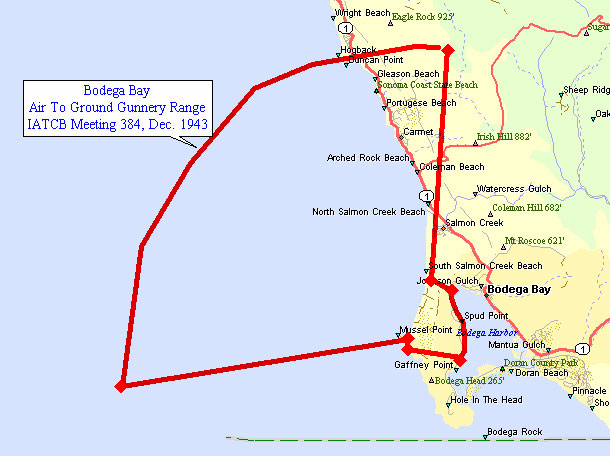
The Army built the Bodega Bay Air to Ground Gunnery Range as one
of three subordinate range activities associated with Santa Rosa
Army Air Field (AAF) approximately 20 miles to the northwest.
The other two subordinate ranges were Tubbs Island Air to Ground
Gunnery Range and Drake's Bay Air to Ground Gunnery Range.
Although a gunnery tow target existed over the water off the coast of Bodega Head by 1941, it appears that it was not until 1943 that the Army Air Forces identified a requirement for a ground range at Bodega Head on the west side of the small bay. The Anny Air Force identified Bodega Head as the location for a dive bombing range needed in the San Francisco area in July 1943. By November, the Army Air Force determined that "an air-to-ground gunnery range and dive and skip bombing range will be required.. .a suitable site has been found in the vicinity of Bodega Bay.. .". The Interdepartmental Air Traffic Control Board (IATCB) approved the 4th Air Force's request for an Air to Ground Gunnery Range at Bodega Bay on 9 December 1943.
By 21 February 1944, the Army had a permit of entry and was completing acquisition on two tracts of land totaling 605 acres. Construction of the Bodega Bay Air to Ground Gunnery Range was to begin immediately thereafter. Although aligned with Santa Rosa AAF, other Army air fields in the area, such as Chico AAF, had use of this range.
The research found no specific details concerning the layout for the ranges at Bodega. By the end of 1944, there were six ranges at Bodega Head, including a ground strafing range and one designated as "X-5" used for overcast firing. The dive and skip bombing missions were reportedly performed at Tubbs Island and Drakes Bay ranges, though at least one bomb target appears to have been constructed at Bodega Bay Air to Ground Gunnery Range. By June 1945, Tubb's Island had been modified to accommodate rocket firing (2.25-inch SCAR) following the Continental Air Forces cancellation of the wavier on rocket firing for the 4th Air Force. There is no indication that Bodega Bay Air to Ground Gunnery Range was also modified for this purpose.
Following the end of the war, the 4th Air Force declared Santa Rosa AAF surplus on 26 November 1945, but desired retention of Bodega Bay range along with the ranges at Tubb's Island and Drake's Bay. The Continental Air Forces requested that Bodega Bay Air to Ground Gunnery Range be declared surplus the following February, but it wasn't until 29 August 1946 that the Army Air Forces did so. The Army canceled the two leases for the range by the end of March 1947 and subsequently the land was returned to private ownership.
In January 1948, the 12th Naval District, headquartered at Naval Air Station Alameda, considered using portions of the Bodega Bay site as a bombing target and took several photographs of the site. A couple of the images show tall telephone pole like posts in the ground a few hundred feet inland from the high water mark of the coastline. The purpose of the poles was believed to be in conjunction with the gunnery targets, but this is only supposition. Neither these photographs nor the aerial photo analysis could confirm the locations, types or number of targets at the Bodega Bay Air to Ground Gunnery Range.

Additional Histories:
US Army Corps of Engineers Archives Search Report